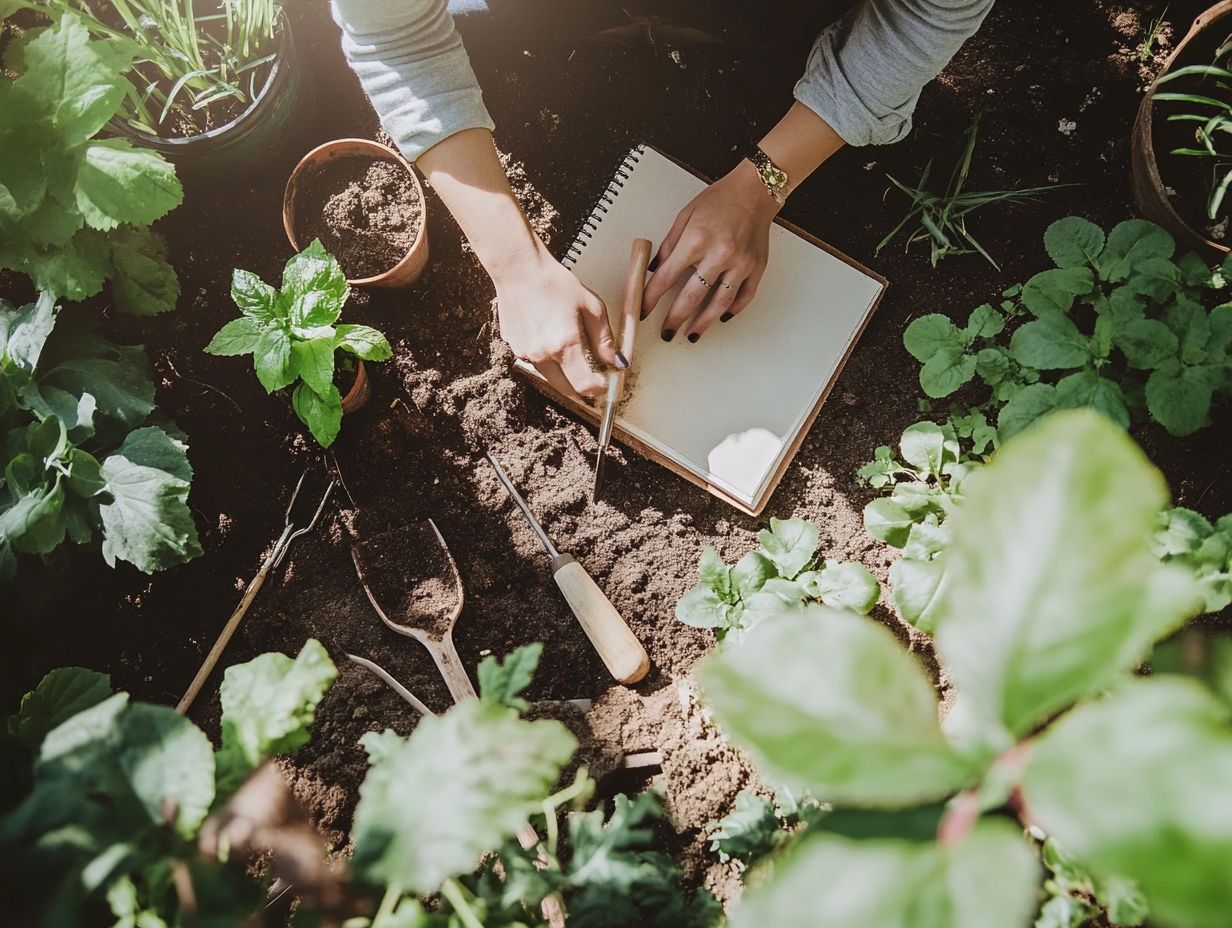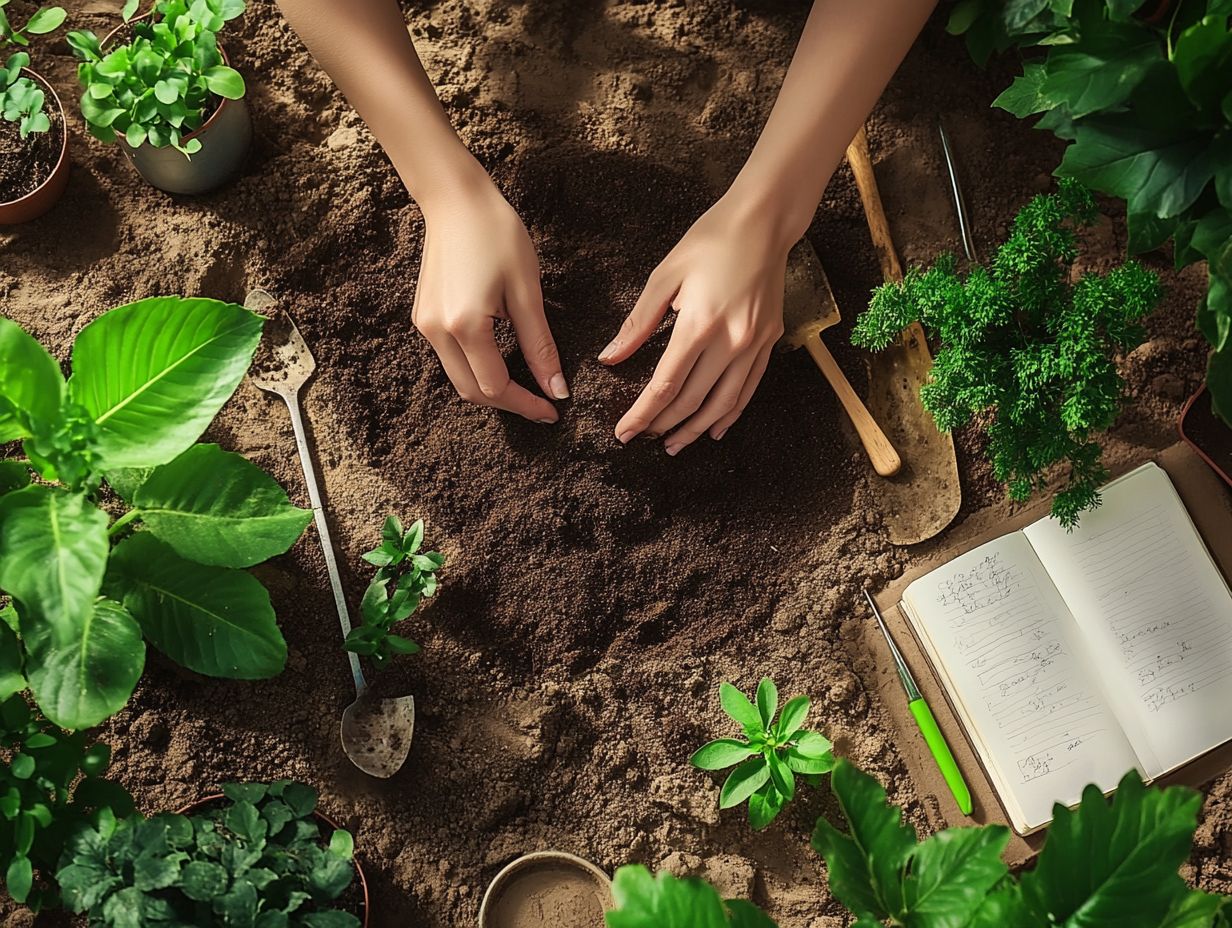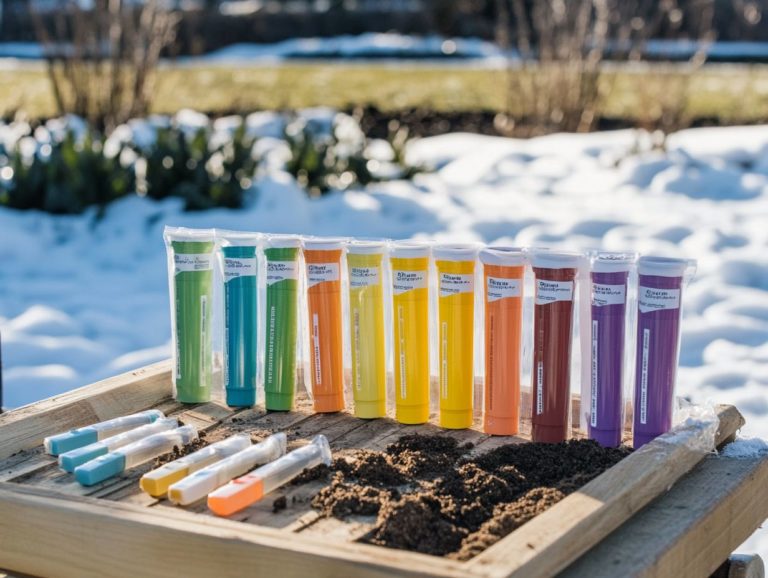How to Create a Soil Care Plan for Your Garden
Healthy soil serves as the foundation of your thriving home garden, yet its vital role is often overlooked by many gardeners. Understanding soil composition, including sand, silt, and clay, is your first step toward nurturing your plants effectively. This guide will empower you to assess your garden’s specific needs, identify any nutrient deficiencies, and determine the appropriate soil pH levels.
You ll explore creating an effective soil care plan, selecting the right fertilizers whether organic or synthetic and implementing mulching strategies. Learn how to monitor your progress and make necessary adjustments to ensure long-lasting soil health and fertility. Get ready to cultivate your dream garden!
Contents
- Key Takeaways:
- Understanding Your Soil
- Assessing Your Garden’s Needs
- Creating a Soil Care Plan
- Choosing the Right Fertilizer
- Implementing Your Soil Care Plan
- Monitoring and Adjusting Your Plan
- Frequently Asked Questions
- 1. Why is it important to create a soil care plan for my garden?
- 2. How do I start creating a soil care plan for my garden?
- 3. What factors should I consider when creating a soil care plan?
- 4. What are some ways to improve the quality of my garden soil?
- 5. How often should I follow my soil care plan?
- 6. Can I create a soil care plan without using chemicals?
Key Takeaways:

- Understand your soil composition, including sand, silt, and clay, to determine its specific needs.
- Assess nutrient deficiencies and soil pH levels to create a tailored soil care plan.
- Choose the right fertilizer, organic or synthetic, and monitor your soil regularly while adjusting your care plan.
Understanding Your Soil
Understanding your soil is fundamental to cultivating a thriving garden, as it serves as the very foundation for successful plant growth and sustainable gardening practices. Healthy soil brims with organic matter, enhancing its structure and moisture retention while providing a nurturing habitat for beneficial microorganisms like earthworms.
To achieve optimal soil health, it’s essential to grasp the composition of your soil, identify the presence of essential nutrients that plants need in larger amounts, and evaluate its soil pH, which is the measure of how acidic or alkaline your soil is. This knowledge empowers you to implement effective soil management techniques that align with local guidelines, such as those established by the Pennsylvania Department of Conservation and Natural Resources.
Soil Composition and Types
Soil composition is crucial for your garden’s health and fertility, affecting everything from water retention to nutrient availability and overall plant growth. It s made up of various particles sand, silt, and clay each playing a unique role in creating the soil texture that influences fertility and drainage.
The delicate balance among these components determines how well your soil can hold moisture and provide essential nutrients to your plants. Sandy soils drain quickly but often struggle to retain nutrients. In contrast, clay-rich soils excel at moisture retention but can become compacted, limiting root growth. Silt offers a fine texture that strikes a balance.
Adding organic matter is key; it improves soil structure and increases nutrient retention and availability, fostering beneficial microbial life. A rich layer of compost ensures that nutrients stay accessible for your plants, making it crucial for cultivating a flourishing garden.
Assessing Your Garden’s Needs
Evaluating your garden’s needs is essential for achieving optimal soil fertility and plant health. Start with a thorough soil test and analysis of soil composition. This test offers invaluable insights into nutrient deficiencies, soil pH levels, and the overall composition of your soil.
With this information, you can customize organic soil amendments and implement effective gardening practices to meet the specific requirements of your plants, ensuring they thrive in their environment.
Identifying Nutrient Deficiencies and pH Levels
Identifying nutrient deficiencies and assessing soil pH levels are essential for your success in organic gardening. They directly impact plant health and growth, including robust yield.
Ensure key nutrients like nitrogen, phosphorus, and potassium are present in balanced amounts to promote strong plant development and enhance soil fertility. To recognize nutrient deficiencies, watch for signs like leaf discoloration or stunted growth, which indicate poor soil health.
A solid understanding of these important nutrients gives you the power to understand their roles: nitrogen encourages leafy growth, phosphorus supports root and flower development, and potassium enhances overall plant vigor.
To maintain optimal soil pH, make it a habit to conduct soil testing regularly. Using home test kits or laboratory analysis reveals acidity or alkalinity levels, and adjusting them can dramatically enhance nutrient availability for your plants.
By fine-tuning these factors, you’ll foster healthier growth and cultivate more resilient plants. You’ll be amazed at how these simple changes can lead to a bountiful harvest and promote sustainable gardening practices.
Creating a Soil Care Plan

Creating a soil care plan is essential for maintaining healthy soil and promoting sustainable gardening practices in your garden beds. For guidance, refer to this resource on how to create a soil management plan, which details the necessary steps for improving soil quality and enhancing its nutrients.
Incorporate various soil amendment techniques, including the addition of compost and organic mulches. By doing so, you will enrich the soil, enhance its structure, and boost its fertility, setting the stage for a thriving garden.
Steps for Improving Soil Quality
Improving soil quality requires a thoughtful approach to soil management that enhances nutrient retention and nurtures a vibrant ecosystem filled with beneficial organisms like earthworms and beneficial insects. You can take strategic steps, including adding organic amendments and utilizing cover crops to elevate soil health.
By incorporating a diverse range of soil amendments such as well-aged compost and manure you can significantly enhance soil fertility while improving its texture and aeration. Planting cover crops like clover or rye during the off-season enriches the soil with organic matter and helps prevent erosion.
Adhering to best practices for composting like maintaining the ideal carbon-to-nitrogen ratio and regularly turning the compost pile is essential for creating nutrient-rich compost. These efforts improve soil structure and promote healthier plants, leading to increased resilience against pests and diseases.
This creates a more sustainable gardening or farming system that benefits the environment.
Choosing the Right Fertilizer
Choosing the right fertilizer is essential for enhancing soil nutrition, which directly influences plant growth and the overall health of your garden. As a gardener, you’ll often weigh the options between organic and synthetic fertilizers, each offering unique benefits and drawbacks.
Your decision will play a pivotal role in cultivating a thriving garden and ensuring healthy soil.
Organic vs. Synthetic Options
Organic fertilizers come from natural materials. They help you maintain healthy soil over time and support sustainable gardening.
In contrast, synthetic fertilizers provide a quick nutrient boost. However, using them too much can harm soil biology and structure.
Choosing organic options like compost and manure releases nutrients slowly. This enhances your soil’s health and helps it retain moisture.
These fertilizers also support beneficial microbial activity. They create a thriving ecosystem for healthy soil microorganisms.
While synthetic fertilizers can quickly nourish crops, manage them carefully. Be aware of potential downsides, like nutrient runoff, which can cause water pollution.
Finding the right balance between organic and synthetic options is crucial. This approach maximizes productivity while keeping soil and the environment healthy.
Implementing Your Soil Care Plan
To implement your soil care plan effectively, use precise application techniques. Engage in continuous maintenance for lasting improvements in soil health.
Incorporate organic matter and utilize mulching. Regularly monitor soil conditions to adjust your approach for optimal moisture levels.
Tips for Application and Maintenance

Effective application is key to improving soil health. Focus on moisture retention and nutrient availability with proper methods.
Start by mixing well-decomposed compost or aged manure into the soil. These amendments nourish plants and improve soil structure.
Applying a layer of organic mulch like straw or wood chips protects against evaporation and helps maintain moisture. Rotate crops and use cover cropping to keep soil vibrant.
Regularly check soil pH and moisture levels. This ensures your amendments are effective and supports lush garden growth.
Monitoring and Adjusting Your Plan
Monitoring your soil care plan is vital for achieving long-term success. Regularly assess soil health and look for improvements in your garden.
By observing plant growth and soil conditions, you empower yourself to make informed decisions. This will elevate your gardening practices.
Signs of Improvement and Adjustments to Make
Identifying signs of improvement in soil health is essential. This helps you know when to adjust your soil care plan. Look out for signs like increased plant vitality, robust root systems, and enhanced moisture retention. These indicate your amendments are making a positive impact.
Healthy plants often flaunt lush foliage, vibrant colors, and a newfound resistance to pests and diseases. This reflects the overall vitality of your garden. When you notice these signs, evaluate your current soil amendments and nutrient levels.
By regularly testing your soil and monitoring plant behavior, you can enhance its structure or acidity as needed. If your plants seem stunted or their colors are off, it may be a signal they need more nutrients or organic matter.
Adapting your care strategies based on these observations creates a cycle of improvement. This ensures your garden thrives sustainably.
Frequently Asked Questions
1. Why is it important to create a soil care plan for my garden?
Creating a soil care plan is vital! Healthy soil means vibrant plants and a thriving garden. Well-maintained soil provides essential nutrients, proper drainage, and a balanced pH for your plants to thrive.
2. How do I start creating a soil care plan for my garden?

The first step is assessing your soil. Perform a soil test to determine its composition, acidity, and nutrient levels. This will help you identify any deficiencies or imbalances that need to be addressed.
3. What factors should I consider when creating a soil care plan?
When creating a soil care plan, consider your garden’s location, climate, plants, and soil type. Each of these factors impacts the specific care and amendments needed.
4. What are some ways to improve the quality of my garden soil?
One effective method is adding organic matter, such as compost or aged manure. These materials boost soil fertility, improve drainage, and promote a healthy ecosystem for beneficial microorganisms.
5. How often should I follow my soil care plan?
The frequency will depend on your garden’s needs and recommendations from your soil test. Generally, perform a soil test every 2-3 years and adjust your plan as needed.
6. Can I create a soil care plan without using chemicals?
Yes! Many natural and organic methods can maintain and improve soil health. These include using compost, cover crops, and organic fertilizers. Avoiding chemicals benefits both the environment and the health of your plants.






